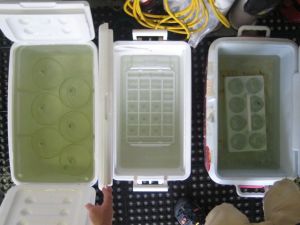Today we searched for “Sub-oxic” bottom water. This is bottom water that has no detectable oxygen (and so is officially “anoxic”) but also has no detectable hydrogen sulfide. We expect to find bacteria using a range of different respiratory metabolisms under these conditions, including nitrate respiration, manganese respiration, and iron respiration. Jeff Cornwell and I got up at 0530 and did a CTD cast at station CB5.2 near the Potomac River mouth. There was no sulfide in the bottom water, but there was a trace of oxygen so we moved the ship north to a new station at 38°14.01N, 76°15.82W and found suboxic conditions. Perfect.
We did our usual morning sampling of sediment cores at three depths and a profile of water samples collected at eight depths from surface to bottom in the deep channel. We started a little late because we had to sample our 24-hour respiration measurements from yesterday. Everything was happening at once – gotta plan that a little better next time. Anyhoo, we collected all our samples while listening to Ian sing the classics, and then dispersed to process. By dinner we started getting ready for our first big experiment – the Electron Acceptor Addition Experiment.

Electron acceptor addition experiment bottles. 2L bottles for gene expression, 60ml bottles for bacteria production, and 300ml bottles for respiration rate
For this experiment we hypothesized that the growth and/or respiration rate of bacteria in suboxic waters is limited by the availability of high-energy electron acceptors like oxygen and nitrate. So we set up incubations in BOD bottles to which we added nitrate (20 micromolar), oxygen (saturated) or nothing (the all important control). Ian, Jeff, and Alex took turns oxygenating (i.e., shaking up) 10 liters of suboxic water in a 20 liter carboy. Mike Owens and Daniel Lee filled BOD bottles, and I carefully dosed several of them with sodium nitrate. We took initial samples for oxygen, nitrate, CO2, bacteria production rate, and gene expression, and then started the incubations. Tomorrow after 24 hours we will sample the triplicate incubations and see if adding electron acceptors changed growth and/or respiration rate. Fingers crossed.



Go go Team Cornwell!